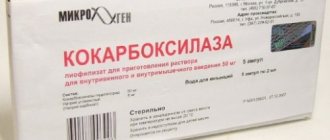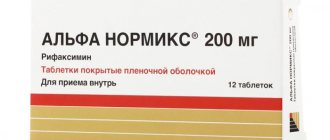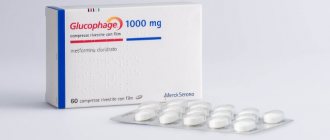Release form and composition
Combilipen has 2 release forms:
- Pills. White, round, biconvex. They do not have a specific smell or taste. Active ingredients: benfotiamine, cyanocobalamin and pyridoxine hydrochloride. Excipients: povidone, calcium stearate, sodium carmellose, microcrystalline cellulose, talc, polysorbate, sucrose.
- Injection. Transparent liquid of pinkish-red color. Has a specific smell. Active ingredients: thiamine hydrochloride, cyanocobalamin, pyridoxine hydrochloride and lidocaine hydrochloride. Excipients: benzyl alcohol, potassium hexacyanoferrate, sodium tripolyphosphate, sodium hydroxide and water for injection.
Recommended dosage
How often can you inject Combilipen? The drug effectively eliminates discomfort, but this does not mean that it can be administered for every painful attack during the day. Most often, doctors prescribe 2 ml of medication (1 ampoule) once a day. Usually this is enough to relieve pain.
In especially severe cases, with the permission of the doctor, the frequency of injections can be increased to 2 times a day. This daily dosage (4 ml) is the maximum allowable. In no case should you exceed it, as this can lead to serious intoxication.
The drug is also prescribed for the prevention of exacerbations in chronic pathologies of peripheral nerves. This helps improve the condition of the nerve fibers and prevent the re-development of pain.
How often can you inject Combilipen for preventive purposes? To prevent exacerbation of the pathology, it is enough to administer 2 ml of the drug once every 2-3 weeks. During the period of remission, more frequent use of the medication is not required.
pharmachologic effect
Combilipen is one of the complex drugs. The drug has metabolic, analgesic and neuroprotective effects. Replenishes deficiency of B vitamins.
Pharmacodynamics
B vitamins are prescribed for the treatment of inflammatory and degenerative lesions of the nerves, as well as the musculoskeletal system.
Thiamine (vitamin B1) is transformed inside the body into cocarboxylase and thiamine triphosphate. These substances take part in the processes of carbohydrate metabolism, promote the restoration of nerve cells and improve the conduction of impulses in the nerves. Tablets and injection solution contain different types of thiamine. The tablet form contains benfotiamine, which is a fat-soluble derivative of thiamine. The solution includes thiamine chloride.
Metabolic products of vitamin B6 take part in the production of physiologically active mediators. Among them are adrenaline, serotonin, dopamine, histamine and tyramine.
Vitamin B12 (cyanocobalamin) promotes the activation of nucleic acids, creatinine, methionine and choline. Has an antianemic effect. Cyanocobalamin reduces pain that occurs due to damage to the peripheral nervous system. Vitamin B12 helps activate the production of folic acid.
Lidocaine has an analgesic effect.
Pharmacokinetics
Thiamine is quickly absorbed once it enters the bloodstream. Vitamin B1 is unevenly distributed in the body. In order to maintain its supply in the body, constant administration of the substance is necessary. Excreted by the kidneys. Compared to other components of Combilipen, thiamine is retained in the smallest quantities.
Pyridoxine is quickly absorbed and distributed throughout the body. About 80% of vitamin B6 is bound to plasma proteins. Pyridoxine is able to penetrate biological fluids, including breast milk. Excreted by the kidneys.
Cyanocobalamin accumulates in the bone marrow. Vitamin B12 is released into the intestines with bile. There it is reabsorbed.
Contraindications
Combilipen is well tolerated and has a minimum of contraindications. It should not be used in patients with acute heart failure and chronic heart failure in the decompensation phase, as well as in case of hypersensitivity to the components of the drug.
Combilipen is contraindicated during pregnancy and lactation, since its active ingredients can cross the placental barrier and penetrate into breast milk. It is also not used in children and adolescents under 18 years of age due to the lack of clinically proven safety data.
Overdose
If the therapeutic dosage of the drug is exceeded, symptoms of overdose may occur. These include:
- nausea;
- vomit;
- hives;
- Quincke's edema;
- dizziness;
- convulsions;
- disturbance of consciousness;
- heart rhythm disturbance.
If any of the above symptoms occur, it is recommended to stop taking the drug and consult a doctor. In the presence of severe overdose, hospitalization is indicated. There is no specific antidote. To alleviate the condition, symptomatic therapy is used.
Side effects
If the instructions are not followed, patients experience adverse reactions.
The most common symptoms are nausea, vomiting, severe headache and dizziness, persistent constipation or frequent loose stools. Patients often talk about increased work of the sweat glands, especially at night. As a rule, this indicates that there is an excess of B vitamins in the body. Tachycardia is considered another side effect. More often, this symptom appears in patients who suffer from chronic pathologies of the cardiovascular system and take medications on an ongoing basis. There are cases of temporary impairment of visual and auditory function, but they are quite rare.
Allergies to the drug often occur, especially if used independently and excessively. A red rash of various shapes and sizes appears on the skin, mild swelling, severe itching, peeling and irritation are observed. If left untreated and continued to take the medication, the symptoms worsen. Much less often, vitamins provoke Quincke's edema or urticaria.
If such symptoms appear, it is recommended to immediately stop taking the drug and seek qualified help. Violation of this recommendation leads to serious consequences.
Interaction
Combilipen is incompatible with ascorbic acid. This is due to the fact that the drug contains cyanocobalamin.
Pyridoxine reduces the effectiveness of Levodopa. Therefore, the drugs are not used simultaneously.
Combilipen is not prescribed together with mercuric chloride, acetate, tannic acid and iodide.
Thiamine is incompatible with phenobarbital, riboflavin, metabisulfite, dextrose and benzylpenicillin.
Combilipen is often prescribed together with nonspecific anti-inflammatory drugs: Movalis, Diclofenac, Meloxicam, Ibuprofen, Dexalgin.
How to store
According to the storage conditions, the solution in ampoules should be placed in the refrigerator, at a temperature of +2...+8°C, out of the reach of children and pets.
Be sure to carefully check the date of manufacture and expiration date of the drug (2 years). Using the solution after the expiration date indicated on the packaging is strictly prohibited.
Kombilipen's analogs
Taking Combilipen may be contraindicated or impossible for a number of other reasons. In such cases, doctors advise using analogues of the drug. The main ones include:
- Milgamma;
- Neuromultivitis;
- Neurobion;
- Pentovit;
- Compligam;
- Neurobion;
- Movalis;
- Mydocalm;
- Cocarnit;
- Vitaxon.
Which is better: Combilipen or Milgamma?
Milgamma is a complex drug whose active substances are B vitamins. The drug has an analgesic, metabolic and neuroprotective effect. Available in the form of tablets and solution for intramuscular administration. Used for medicinal and prophylactic purposes. The main indications for prescribing Milgamma include:
- neuritis;
- neuralgia;
- neuropathy of various origins;
- convulsive syndrome;
- complex therapy of degenerative-dystrophic diseases of the spine.
The drug is not used in the presence of individual intolerance to its components, heart failure in the stage of decompensation, during pregnancy and lactation, as well as in childhood.
Combilipen and Milgamma belong to the same pharmacological group. Used to treat various neurological conditions. Medicines have similar active substances, release forms, and contraindications for use. The differences between the drugs are as follows:
- Milgamma is produced by a German pharmaceutical company. Combilipen is a domestically produced drug;
- Milgamma contains a larger number of excipients that increase the absorption of vitamins;
- Milgamma is less likely to cause side effects compared to Combilipen.
Before purchasing medications from a pharmacy, it is recommended to consult a doctor. The specialist will be able to select the required dosage, frequency of administration and duration of treatment.
Which is better: Combilipen or Neuromultivit?
Neuromultivitis is a complex medicine. The active components of the drug are pyridoxine, thiamine, cyanocobalamin. It is produced in the form of tablets and solution for intramuscular administration. Neuromultivitis has neurometabolic and analgesic effects. Indications for prescribing the drug are:
- diabetic and alcoholic polyneuropathy;
- neuralgia of various origins;
- radicular syndrome;
- neuritis;
- lumboischialgia.
Neuromultivit is not prescribed in case of individual intolerance to the components of the drug, during pregnancy and breastfeeding, or in the presence of heart failure.
Combilipen and Neuromultivit are representatives of the same pharmacological group. The drugs are prescribed for the presence of various neurological diseases. Available in the form of tablets and solution for intramuscular administration. A similar composition provides the same indications, side effects and contraindications.
The excipient of Combilipen is lidocaine. It allows you to reduce pain during injection of the drug. Neuromultivit does not contain this component. Neuromultivit is produced by a European pharmaceutical company. Combilipen is a domestically produced medicine.
Which is better: Combilipen or Neurobion?
Neurobion is one of the complex preparations that contain B vitamins. It is available in the form of tablets and solution for injection. The drug helps to replenish vitamin deficiency and has an analgesic and neurometabolic effect. Among the main indications for prescribing the drug are:
- neuralgia;
- neuritis;
- pain syndrome caused by degenerative-dystrophic diseases of the musculoskeletal system.
Neurobion is not used during pregnancy and lactation. This is due to the high levels of vitamins. In addition, the drug is contraindicated in case of individual intolerance to its components, under the age of 18 years.
Combilipen and Neurobion are combined vitamin complexes. The drugs are similar in composition, indications for use, release form and side effects. Neurobion is produced by a European pharmaceutical company, Combilipen is a domestic drug.
Which is better: Combilipen or Pentovit?
Pentovit is a multivitamin complex medicine. The active ingredients of the drug are pyridoxine, thiamine, folic acid, cyanocobalamin and nicotinamide. Produced in tablet form. Among the main indications for prescribing Pentovit are:
- dermatitis;
- neuralgia of various origins;
- hypovitaminosis;
- asthenia;
- rehabilitation period after infectious diseases.
The dosage, frequency of administration and duration of treatment are selected by the doctor individually. Pentovit is not used in pediatric practice. During pregnancy, the drug can be included in therapy if there are strict indications.
Pentovit and Combilipen belong to the same pharmacological group of drugs. The drugs are prescribed to treat various neurological diseases. Pentovit is available in tablet form. Combilipen is produced in the form of tablets and solution for injection. This provides a wider range of indications.
Which is better: Combilipen or Compligam?
Compligam is a multivitamin medicine. The drug contains active ingredients cyanocobalamin, thiamine, pyridoxine and lidocaine. Compligam has a local anesthetic and analgesic effect. Produced in the form of tablets and solution for injection. Normalizes blood circulation and stimulates hematopoiesis. The main indications for prescribing the drug are:
- intercostal neuralgia;
- paresis;
- neuritis;
- convulsive syndrome;
- polyneuropathy of various origins;
- trigeminal neuralgia;
- pain syndrome due to degenerative-dystrophic diseases of the musculoskeletal system.
Compligam is not prescribed during pregnancy and lactation. The drug is not used in pediatric practice and for heart failure in the stage of decompensation.
Combilipen and Compligam belong to the same pharmacological group. A similar composition provides the same indications and contraindications for use, as well as side effects. Both drugs are produced by a domestic manufacturer.
Which is better: Combilipen or Neurobion?
Neurobion is a multivitamin medicine. The active ingredients of the drug are thiamine hydrochloride, pyridoxine hydrochloride and cyanocobalamin. Produced in the form of tablets and solution for injection. Neurobion is prescribed for the presence of various neurological diseases. The drug replenishes vitamin deficiencies, has a positive effect on the condition of nerve endings and improves impulse conduction. The main indications for prescribing Neurobion include:
- radicular syndrome;
- Bell's palsy;
- neuralgia of various origins;
- degenerative-dystrophic diseases of the musculoskeletal system.
There is no data on the negative effects of the drug on the fetus during pregnancy. However, doctors recommend using the drug only if there are strict indications and under the supervision of a specialist.
Combilipen and Neurobion are representatives of the same pharmacological group. Both drugs contain B vitamins, are prescribed for the treatment of neurological diseases, and are available in the form of tablets and injection solution. Before using medications, it is recommended to consult a doctor. The specialist will be able to assess the severity of the condition, select the most effective dosage, frequency of administration and duration of treatment. Self-medication can lead to various consequences.
Which is better: Combilipen or Movalis?
Movalis is a representative of the group of nonspecific anti-inflammatory drugs. The active substance is meloxicam. Available in the form of tablets, solution for injection, rectal suppositories and suspension. It has analgesic, anti-inflammatory and antipyretic effects. The main indications for the use of Movalis are degenerative-dystrophic diseases of the musculoskeletal system. The drug is part of the treatment of diseases such as:
- osteochondrosis;
- arthrosis;
- arthritis;
- chronic pain syndrome
The drug is not recommended for use during pregnancy and lactation.
Combilipen and Movalis are prescribed for the treatment of neurological diseases. The differences between the drugs are as follows:
- Combilipen is a complex drug whose active substances are B vitamins. Movalis is a nonspecific anti-inflammatory drug;
- The active ingredients of Combilipen are cyanocobalamin, thiamine and pyridoxine. The active substance of Movalis is considered meloxicam;
- Combilipen is available in the form of tablets and solution for injection. Movalis is produced in the form of a solution for injection, rectal suppositories, tablets and suspension for oral administration. The variety of shapes provides a wider range of uses.
Doctors often practice co-prescribing Kombilipen and Movalis. Such complex therapy allows you to shorten the treatment period.
Which is better: Combilipen or Mydocalm?
Mydocalm is a muscle relaxant drug. The active ingredient of the drug is tolperisone. Mydocalm is available in the form of tablets and solution for injection. It has a membrane-stabilizing and local anesthetic effect. Indications for the appointment of Mydocalm are:
- spasms of striated muscles;
- diseases of the central nervous system of various origins;
- muscle contractures and spasms;
- degenerative-dystrophic diseases of the musculoskeletal system;
- rehabilitation period after surgery;
- combination therapy for obliterating vascular diseases;
- disruption of vascular innervation.
Mydocalm is not used in cases of hypersensitivity to its components, with myasthenia gravis, during pregnancy and lactation, as well as in children under 3 years of age.
Combilipen and Mydocalm belong to different pharmacological groups of drugs. The active substance of Mydocalm is tolperisone. Combilipen contains active ingredients: thiamine, pyridoxine, cyanocobalamin. The drugs are available in the form of tablets and solution for injection. If there are certain indications, they can be used together as part of complex therapy for various neurological diseases.
Which is better: Combilipen or Cocarnit?
Cocarnit is a complex drug. The drug contains cyanocobalamin, cocarboxylase, nicotinamide and adenosine triphosphate. Available in the form of a lyophilisate for preparing a solution. Cocarnit has a neurometabolic and analgesic effect, and has a positive effect on the emotional background. The main indications for prescribing the drug are:
- neuritis;
- neuralgia of various origins;
- sciatica;
- bursitis;
- tendinitis;
- myalgia;
- radiculitis;
- neuropathy.
Cocarnit is used as part of complex therapy for coronary heart disease and myocarditis. Can be prescribed during pregnancy if there are strict indications and under the supervision of a doctor.
Combilipen and Cocarnit belong to the same pharmacological group. Prescribed for the treatment of neurological diseases. The drugs differ in composition. The active substances of Cocarnit are nicotinamide, cocarboxylase, cyanocobalamin and adenosine triphosphate. Combilipen contains pyridoxine, thiamine and cyanocobalamin. Cocarnit is produced in the form of a lyophilisate for the preparation of a solution. The release forms of Combilipen are tablets and solution for injection. Combilipen is not prescribed during pregnancy and lactation. Cocarnit has no such restrictions. Before using medications, it is recommended to consult a doctor. The specialist will be able to assess the severity of the condition, prescribe the necessary dosage, frequency of administration and duration of treatment.
Which is better: Combilipen or Vitaxon?
Vitaxon is a neurotropic drug. The active ingredients of the drug are thiamine, pyridoxine and cyanocobalamin. Produced in the form of tablets and solution for injection. Prescribed as part of complex therapy for various neurological diseases. The main indications for prescribing Vitaxon include:
- myalgia;
- neuralgia;
- radicular syndrome;
- polyneuropathy of various origins;
- neuritis;
- withdrawal syndrome.
The drug is not used during pregnancy and lactation, as well as in childhood, in the presence of chronic heart failure in the decompensation stage.
Kombilipen and Vitaxon are representatives of complex preparations containing B vitamins. Both drugs are produced in the form of tablets and injection solution. The similar composition of the drugs explains the same indications and contraindications for use, as well as side effects. Vitaxon is a Ukrainian-made medicine. Combilipen is produced by a domestic pharmaceutical company.
Instructions for using injections
It is recommended to inject Combilipen intramuscularly for severe pain every day. How many days the course of treatment will last depends on the nature of the disease, the patient’s condition, and tolerability of the medication. As a rule, 5–10 injections are sufficient. In the future, they switch to oral administration of the drug or reduce the dosage, giving injections every other day or once every two days. The maximum daily dose is 2 ml (1 ampoule).
How to prick correctly
The injection solution is injected deep into the buttock muscle. The standard injection site is its upper lateral part: a large volume of muscle tissue in this area helps to create a kind of “depot”, due to which the active substances of the drug are gradually released and enter the blood.
In addition, in the upper lateral zone of the buttock there are no large blood vessels and nerve trunks that can be touched during the injection. Therefore, administering the drug in this area is the safest.
Indications
Combilipen is part of a complex treatment for trigeminal neuralgia, as well as for neuritis of the facial nerve.
It is used in the presence of pain syndrome arising from diseases of the spine (lumboischialgia, intercostal neuralgia, lumbar, cervical and cervicobrachial syndromes, as well as radicular syndrome, which was caused by degenerative changes in the vertebrae).
It can be prescribed for various polyneuropathies, for example, alcoholic or diabetic.
Possible treatment regimens
After relief of acute pain, the patient is transferred to maintenance therapy. The following treatment regimens are used:
- The patient continues to receive injections of the drug "Combilipen", but much less frequently. It is gradually transferred to a prophylactic dose and 2 ml of solution is administered once every 2-3 weeks.
- The injections are completely canceled and the drug “Combilipen Tabs” is prescribed. Tablets should be taken 1 piece after meals 1 time per day. The course of treatment lasts 14 days.










